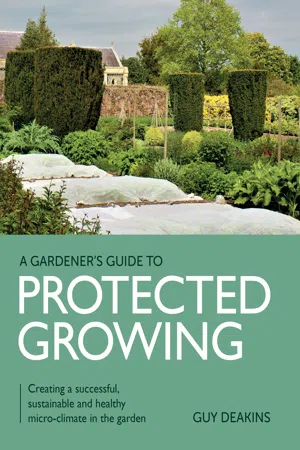![]()
CHAPTER 1
SHELTERS AND SCREENS
Shelter
In her book, Seaside Gardening (1962), Christine Kelway says on the effects of wind:
It is, therefore, in the interests of all gardeners, no matter their situation, to provide as much shelter from desiccating winds as possible. It is all very well for Derek Jarman to have romantically stated, ‘There are no walls or fences. My garden’s boundaries are the horizon’, (from his diary, published in Modern Nature 1991 and subsequently used as the title of a major exhibition of his work at the Garden Museum, Lambeth 2020). Even he admitted that a gorse hedge would have suited the situation well to provide some shelter. Beautiful though his garden is at Dungeness, his planting palette was drastically reduced to the hardiest of plants.
Taking this as your first lesson, in order to identify threats from the natural environment correctly, first look to see where the prevailing winds come from. This is easily done if you look at the shape of local trees. If exposed to strong winds they will grow in a particular way, the exposed side becoming more aerodynamic, often growing away from the buffeting. Another method is to look at local woodlands or mature hedgerows, if one is nearby. The trees most exposed to high winds will have thicker trunks than those less exposed. This is the side your garden will need protection from the most. The predominant wind in the UK is from the south-west, but if you are on the more exposed eastern side, you may need a north or north-easterly screen too.
Derek Jarman Exhibtion. Garden Museum 2020. His ‘open’ garden withstood one of the harshest climates, but his planting palette was much restricted.
Prevailing winds can be harsh. This tree on the South Downs at Chanctonbury is obviously affected by ‘Westerlies’ moving from left to right of the image.
You will also need to decide what form of shelter you need for your purposes. A hedge or fence is ideal if you are simply aiming to slow the worst of the weather – but choose wisely. A brick wall or concrete fence is ideal if you want to grow trained fruit and retain some heat. A greenhouse, polytunnel or lean-to glass is the next level – but that will need protection itself! Above all, consider your budget and the limitations of space.
Ask an Expert
What are the basic tenets of working within an historic walled garden?
• Making use of the walls for their intended purpose (creating a microclimate) – retaining heat for longer/more efficient cropping and growing trained fruit trees.
• Cyclical seasonal maintenance of annual crops, including successional sowings and trained fruit-tree upkeep, e.g. pruning, feeding and mulching.
• Ensuring that the most appropriate crops are grown according to aspect (south-facing wall, north wall, etc.).
• Making use of glasshouses, some of them heated, where the growing season can be extended and exotic species of fruit and vegetables can be produced, especially historically, e.g. peaches, pineapples and grapevines.
• Crop rotation in the vegetable garden.
• Using traditional Victorian techniques, where possible.
• Putting on a show for our visiting public, e.g. full attractive vegetable plots, herbaceous borders (cut flowers), iris and peony border, in an historic setting.
• Using ‘heritage’ varieties, where available/appropriate.
• Growing productively for our local vegetable box outlets (Cambridge organic: https://www.cofco.co.uk/ and Nourish Linton: https://nourishlinton.com/).
Inheriting an Existing Shelter
Audley End, near Saffron Walden in Essex, is an interesting historical garden. First laid out in 1605, the house and gardens have seen many changes over the years. One striking feature (among many) is the restored kitchen garden, which has been worked for many centuries and is now run on an entirely organic ethos by English Heritage.
The walled garden, Bishops Palace, Fulham. A fine example of a garden designed purely for protective growing.
The walled garden at Mount Ephraim, Kent. This garden combines a high wall with a high hedge to create a microclimate.
Something often overlooked is what is already there. Whether your space has an existing structure, hedge, treeline or is open to everything, it already has a microclimate. It is worth bearing in mind that all the plants in that space will be growing in that created environment, with that climate as its ‘norm’. Assess what benefits the existing situation has and if structural change will be of detriment to the established microclimate. Perhaps a hedge is overgrown or a wall is badly damaged and needs demolishing? If you have plants in the garden that are tender or require specific growing conditions, understand the threat of creating a new microclimate by lowering or removing what is already there. The same goes with new introductions to the space that may create possible frost pockets and wind tunnels or block a natural run-off. Soil damage is also a major consideration when using machinery.
The rule of thumb is to think carefully before creation.
Artificial Shelter
The Wall
Attractive and long-lived, a well-built wall can be a positive in any garden. Undeniably, it is a very versatile structure if used correctly – it being most suitable to grow fruit trees against, ideal for lean-to structures or walled gardens.
Brick walls are robust but will degrade with weathering and damage.
Another factor to consider is the integrity of the wall structure.
This low wall with ornate metal railings still offers protection, especially as it is so close to the warm house. Private residence.
In the book The Gardener’s Assistant by William Watson (1925), the author describes a wall of six or seven feet (c. 2m) as being ‘adequate’ but ‘15 feet [4.5m] or more in height would certainly prove very advantageous’. Unless the gardener has no local byelaws to contend with, this idea is pretty impractical in both scope and the majority of budgets. There is also the disadvantage that a wall only fully protects those in the direct lee of its shelter.
However, before it is dismissed out of hand, a good garden wall does have the advantage of being both a shelter and a heat sink. A professional should always be consulted when building a wall of any substance but should an amateur wish an attempt – any description of how is beyond the realms of this book – it is a requirement to check government rules and regulations concerning permanent brick or stone structures and to consult the local buildings’ officer.
If you have inherited a wall, then it is wise to inspect the structure ...








